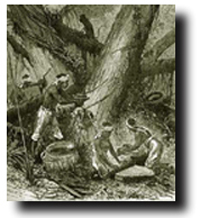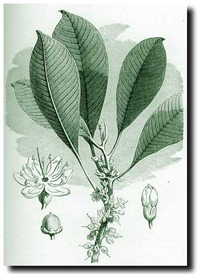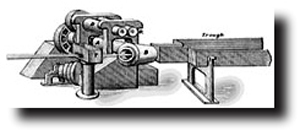

What is gutta-percha? Before telegraph cables could work underwater, it was necessary to develop a cable with good waterproofing and electrical insulation. In the age before the development of man-made plastics, a material had to be found which would fulfil these requirements. Fortunately, gutta-percha, a resin from the Isonandra Gutta tree was identified as a suitable insulating material. This material, found just a few years earlier in Malaya, was presented to Cyrus Field by Samuel Canning who would come to be a member of the first transatlantic cable expedition. From Samuel Canning, Mr. Field learned of the difficulties of keeping the copper wires in the cable insulated because of the conductive medium from the ocean that surrounded the wire. Gutta-percha seemed to have the required properties for this task.
 Gutta-percha was produced by evaporating the milky fluid of the
gutta-percha tree and coagulating the latex from which an inelastic firm
insulator resulted. This material softened in hot water. It had a distinct
advantage over India rubber that had been used in earlier cables because, on
cooling, it became hard without becoming brittle. It was ideally suited for
underwater use where the cold and pressure improved its insulating
qualities. Submersion also kept the cable away from sunlight which had a
deteriorating effect on the cable. The crossing of the Atlantic Ocean by
cable was viewed by the scientists involved in the gutta-percha work as the
ultimate test of the material.
Gutta-percha was produced by evaporating the milky fluid of the
gutta-percha tree and coagulating the latex from which an inelastic firm
insulator resulted. This material softened in hot water. It had a distinct
advantage over India rubber that had been used in earlier cables because, on
cooling, it became hard without becoming brittle. It was ideally suited for
underwater use where the cold and pressure improved its insulating
qualities. Submersion also kept the cable away from sunlight which had a
deteriorating effect on the cable. The crossing of the Atlantic Ocean by
cable was viewed by the scientists involved in the gutta-percha work as the
ultimate test of the material.
 Locally made items of this material were
brought to Europe from the Malay Peninsula and specimens were exhibited at the
Royal Society of Arts in London in 1843. It was subsequently imported and
used for various applications, including jewellery making.
Locally made items of this material were
brought to Europe from the Malay Peninsula and specimens were exhibited at the
Royal Society of Arts in London in 1843. It was subsequently imported and
used for various applications, including jewellery making.
The discovery of a form of rubber called gutta-percha in 1843 led to the manufacture of a suitable insulation by 1847.
In 1845, the S. W. Silver & Co. of Stratford, East London, invented a
means of extruding gutta-percha to cover wire (see picture below).  Gutta-percha was the best cable insulation available and it was used to
insulate the telegraph lines along the Great Western Railroad in 1843. The lines
consisted of five copper conductor wires, covered with gutta-percha and
supported in wooden blocks.
Gutta-percha was the best cable insulation available and it was used to
insulate the telegraph lines along the Great Western Railroad in 1843. The lines
consisted of five copper conductor wires, covered with gutta-percha and
supported in wooden blocks.
The real beginnings of global submarine cable telegraphy began with a wealthy English merchant family named Brett, who financed a cable crossing the English Channel to France in 1850. That cable failed after only a few messages had been exchanged, and was finally replaced with an engineered design that could withstand the currents at the bottom of the Channel in September 1851.
A waterproof insulating material was needed for the outdoor cable. Gutta-percha, a resin from the Isonandra Gutta tree, was imported from the Malay Peninsula and tested for wire insulation. This material was a good insulator; it provided an inelastic, firm insulation. It softened in warm water and was hard but not brittle when cooled. The only problem with gutta-percha was that it deteriorated in direct sunlight.
